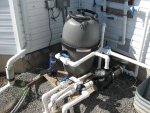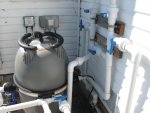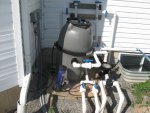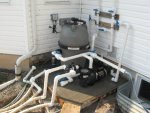As you can see in the attached photos below, the piping installed by the pool contractor is a bit ugly and I would like to correct a few problems by redoing the piping. The main problem is that the pool heater (shell & tube heat exchanger visible on wall below the siding) is poorly accessible and impossible to drain without disassembling the piping. The other problem is that the pool drain is a hose that runs across the back of the house and onto my side lawn.
The photos show the pump & filter as assembled by the contractor. Because the pump was being installed in a different location than originally planned (long story), the contractor suggested that we pour the pad after the pump and filter were installed. To compensate for the height of the pad, he set the everything on a board and 2x4s, which made it even uglier. The pump and filter now sit on a concrete pad and I plan to put a weather enclosure around it later.
Since I have a 4" rainwater drain pipe very close to the pool filter, I want to extend a 2" pipe from the pool filter's drain connection to the 4" pipe. Although I can use an elbow at the filter, it makes more sense to me to turn the filter 90° so that the filter's inlet is in line with the pump and only one long-radius 2" elbow is used to connect them. Currently, the pump is connected with 1-1/2" piping using 3 elbows and a tee. Because the fittings were glued so close together, I can't reuse the existing tail pieces
The assembly drawings in my owner's manuals suggest that I will need the following to redo the piping:
Would anyone know if there is cheaper way to connect up to the filter and pump than to use the Jandy PNs? The parts are expensive for a half union and I can't really be sure that I'm getting what I want. When I called up Jandy, I got the impression that PN R0461800 was all I needed. However, in checking with some on-line pool stores, the product photo shows everything BUT what I need.
Can I use half of a union (like NIBCO PN 457-020) to connect up to the half unions on the cartridge filter and the pump?
If not, can anyone suggest what I really need and the best place to buy it?
The photos show the pump & filter as assembled by the contractor. Because the pump was being installed in a different location than originally planned (long story), the contractor suggested that we pour the pad after the pump and filter were installed. To compensate for the height of the pad, he set the everything on a board and 2x4s, which made it even uglier. The pump and filter now sit on a concrete pad and I plan to put a weather enclosure around it later.
Since I have a 4" rainwater drain pipe very close to the pool filter, I want to extend a 2" pipe from the pool filter's drain connection to the 4" pipe. Although I can use an elbow at the filter, it makes more sense to me to turn the filter 90° so that the filter's inlet is in line with the pump and only one long-radius 2" elbow is used to connect them. Currently, the pump is connected with 1-1/2" piping using 3 elbows and a tee. Because the fittings were glued so close together, I can't reuse the existing tail pieces
The assembly drawings in my owner's manuals suggest that I will need the following to redo the piping:
- PN R0461800 - Universal Half Unions (Set of 3) and Drain Plug Cap - for the filter[/*:m:3m71jo4p]
- PN R0327301 - Tailpiece, O-ring & Union Nut (Set of 2) - for the pump discharge connection[/*:m:3m71jo4p]
Would anyone know if there is cheaper way to connect up to the filter and pump than to use the Jandy PNs? The parts are expensive for a half union and I can't really be sure that I'm getting what I want. When I called up Jandy, I got the impression that PN R0461800 was all I needed. However, in checking with some on-line pool stores, the product photo shows everything BUT what I need.
Can I use half of a union (like NIBCO PN 457-020) to connect up to the half unions on the cartridge filter and the pump?
If not, can anyone suggest what I really need and the best place to buy it?







